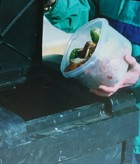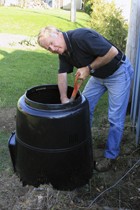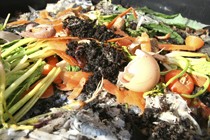Composting is a very basic process. You can simply toss grass clippings and leaves in a heap and let nature do the rest in its own good time, or you can help it along, by providing a balanced diet for the micro-organisms who'll do most of the work, as well as a home that meets their needs.
Just like us, these decomposer organisms have three basic requirements: air, water, and food.
Air provides oxygen and enables bacteria to carry out "aerobic" decomposition. Without oxygen, "anaerobic" decomposition of the waste may take place instead. This is something we normally want to avoid, since anaerobic bacteria produce the rotten-egg smell often associated with decay.
There are two methods of aerobic composting, depending on whether or not the pile heats up. A "cold" compost pile will decompose as surely as a "hot" one, but it'll take much longer.
The Compost Recipe
Air
Air penetrates only the top layers of the pile, so it needs help to reach the centre. A vile smell around the compost tells you that anaerobic bacteria are moving in, and the pile may simply need to breathe. In hot composting, plenty of air is essential to develop the high temperatures that kill pathogens and speed the process of decomposition.
Air Stacks
Another approach is to build your compost pile around a perforated pipe, a bundle of long twigs, or a tube of wire mesh standing on end. This carries air to the centre between turnings. With air stacks, you can skip the turning, although the pile won't heat up as efficiently.
Elevated Compost
Most compost piles rest on bare ground, but you can build the pile on a raised platform of loosely spaced boards, allowing air to be drawn up from the bottom. If you elevate your compost, however, be sure to sprinkle garden soil through the compost to introduce those essential soil bacteria.
Water
Your compost pile should be as damp as a wrung-out sponge, moist to the touch, but no water should come out when you squeeze a handful.
Too dry?
You can poke holes in the pile and water it from the top with a trickling hose. Better yet, pull the pile apart and rebuild it, wetting each layer as it goes on. Very fibrous materials such as dead leaves may need to be soaked in a bucket for an hour or two.
Too wet?
A soggy pile should be turned so that clumps of material are broken up, letting air in and water out. If the compost is absolutely soaked, you can spread the materials to dry in the sun, or scatter peat moss through the pile as you rebuild it with the drier materials in the centre.

Cold composting is slow but it's easy. Someone with more space for compost than physical energy and time to devote to it may opt for the "cold" approach. This could also be the method to choose if your primary concern is reducing waste, rather than making quantities of compost.
In contrast, hot composting is a fairly fast method of creating compost and makes efficient use of smaller spaces. It does take more physical effort than cold composting, but gardeners who want as much compost as possible will usually choose this method.
There are many variations of approach, as individual as the people who compost. You might pick one method to start with and adapt it, as you gain experience over time. Above all, keep your system simple, convenient, and suited to your lifestyle.

Turning
The most effective method of introducing air is to turn the pile with a garden fork. Lift the material from the top and sides, toss it into the more active centre of the new pile, then add the partially decomposed centre to the outside.
Stirring
If you would rather not do the work of turning a pile, try stirring it with a stick instead; this won't distribute the air as evenly, however, so the composting process will be somewhat slower.
Aerator Tools
You can buy an aerator, a rod with flaps on one end and a handle on the other, at a garden centre. You jab the tool into the compost pile, and the flaps unfold to loosen the materials as you pull it back out. The result is easier than turning and produces more air than stirring.

Food
Decomposer organisms work best with as varied a diet as you can feed them. The ingredients are all around us, almost anything that once lived is a candidate for the compost, so try for lots of variety to get a good mix of textures and plant nutrients.
In composting jargon, woody materials that are high in carbon (autumn leaves, paper, peat moss, sawdust, cornstalks, hay and straw, etc.) are called "brown" ingredients. Materials like garden refuse, manure, tea and coffee grounds, feathers, hair, and food scraps are high in nitrogen, or "green." Some materials can actually be both: fresh grass clippings are "green," for example, but dried grass is "brown."
For successful results, you can use the simple rule that compost needs to be about half "brown" and half "green" by weight. Don't bother to weigh your ingredients, though: an estimate is fine. Composting soon becomes a matter of instinct, like the cook who bakes without a recipe. If the pile doesn't heat up, you know there's not enough "green" in the mix, while a smell of ammonia means it needs more "brown."
